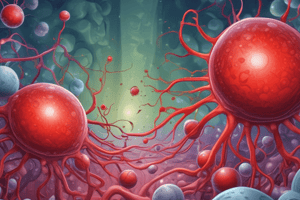Podcast
Questions and Answers
What is the primary characteristic of bleeding associated with platelet disorders?
What is the primary characteristic of bleeding associated with platelet disorders?
- Bleeding from large vessels
- Bleeding from joints and muscles
- Bleeding from organs and parenchymal tissues
- Bleeding from small vessels of mucous membranes and skin (correct)
What is the term for a decrease in the number of platelets in the blood?
What is the term for a decrease in the number of platelets in the blood?
- Platelet dysfunction
- Thrombocytosis
- Thrombocytopenia (correct)
- Platelet deficiency
What is the significance of petechiae in bleeding disorders?
What is the significance of petechiae in bleeding disorders?
- Indicates vitamin K deficiency
- Indicates platelet dysfunction
- Indicates platelet deficiency (correct)
- Indicates liver disease
What is the normal range for platelet count above which bleeding risk decreases?
What is the normal range for platelet count above which bleeding risk decreases?
What type of bleeding is often seen in thrombocytopenia?
What type of bleeding is often seen in thrombocytopenia?
A patient with thrombocytopenia is experiencing spontaneous bleeding. Which of the following vessels is most likely to be affected?
A patient with thrombocytopenia is experiencing spontaneous bleeding. Which of the following vessels is most likely to be affected?
A decrease in platelet production can lead to which of the following disorders?
A decrease in platelet production can lead to which of the following disorders?
What is the primary difference between petechiae and purpura?
What is the primary difference between petechiae and purpura?
Which of the following statements about thrombocytopenia is true?
Which of the following statements about thrombocytopenia is true?
Which of the following is a possible mechanism leading to bleeding disorders?
Which of the following is a possible mechanism leading to bleeding disorders?
Flashcards are hidden until you start studying
Study Notes
Bleeding Associated with Platelet Disorders
- Platelet disorders result from a decrease in the number of platelets due to either decreased platelet production, increased destruction, or impaired function.
Characteristics of Bleeding
- Spontaneous bleeding often occurs in small vessels of mucous membranes and skin, specifically in the mouth, nose, GI tract, and uterine cavity.
Cutaneous Bleeding
- Characterized by pinpoint hemorrhages (petechiae) and bruising (purpura).
- Petechiae indicate platelet deficiency, not dysfunction.
Thrombocytopenia
- Defined as reduced platelets, with a count of less than 150,000/μL.
- The lower the platelet count, the higher the bleeding risk.
- Severe thrombocytopenia is associated with a higher risk of bleeding.
Bleeding Associated with Platelet Disorders
- Platelet disorders result from a decrease in the number of platelets due to either decreased platelet production, increased destruction, or impaired function.
Characteristics of Bleeding
- Spontaneous bleeding often occurs in small vessels of mucous membranes and skin, specifically in the mouth, nose, GI tract, and uterine cavity.
Cutaneous Bleeding
- Characterized by pinpoint hemorrhages (petechiae) and bruising (purpura).
- Petechiae indicate platelet deficiency, not dysfunction.
Thrombocytopenia
- Defined as reduced platelets, with a count of less than 150,000/μL.
- The lower the platelet count, the higher the bleeding risk.
- Severe thrombocytopenia is associated with a higher risk of bleeding.
Studying That Suits You
Use AI to generate personalized quizzes and flashcards to suit your learning preferences.




